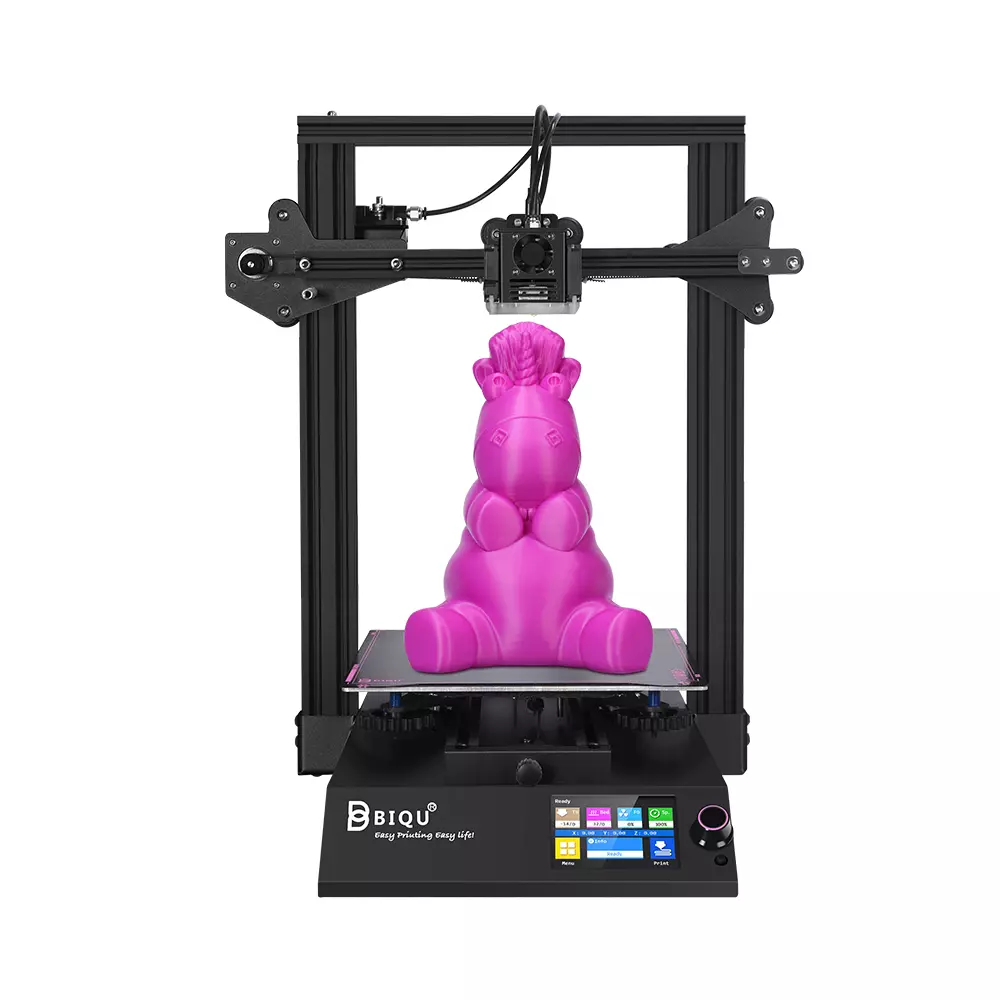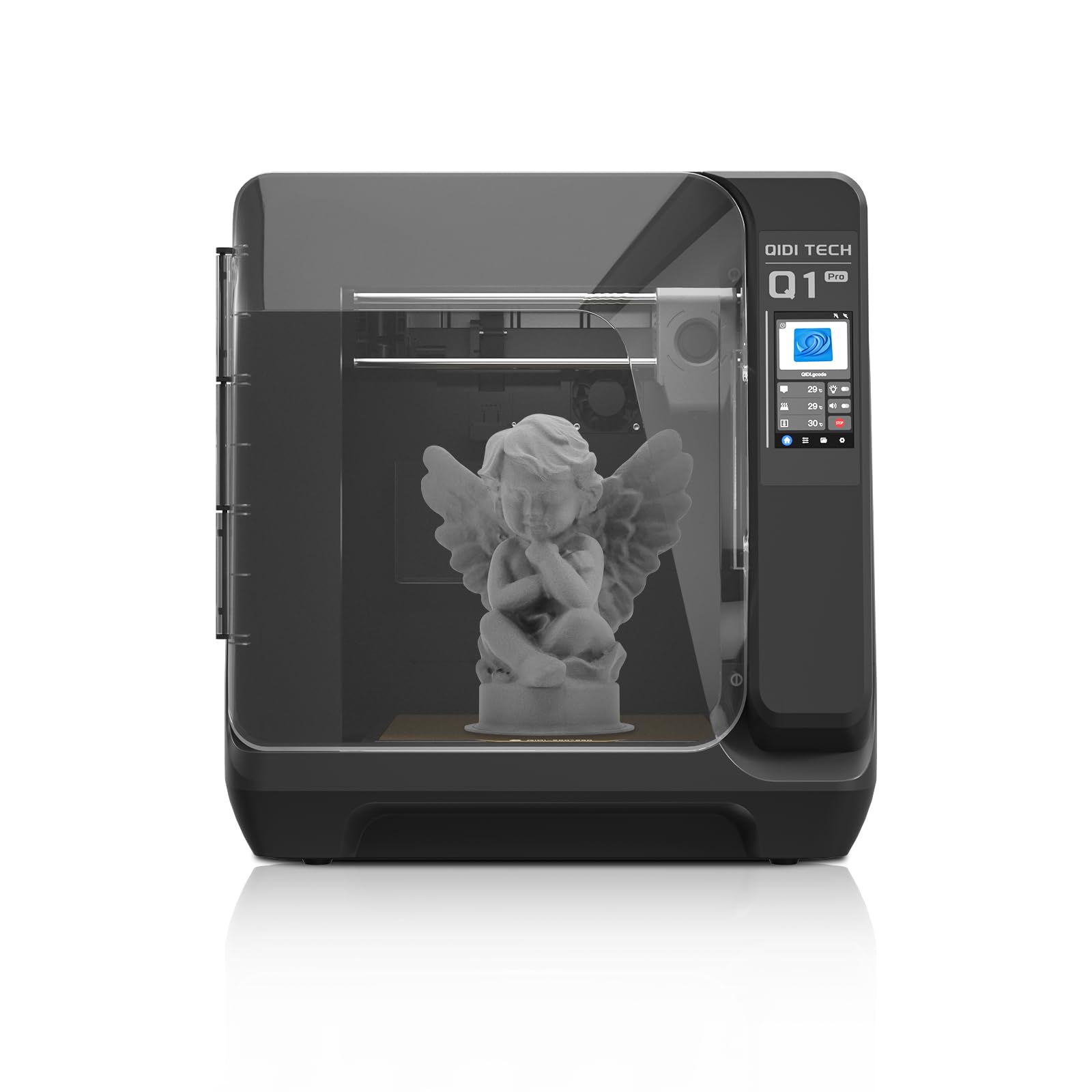Compare BIQU B1 vs Q1 PRO
Comparison between the best 3D printers
Choose the best 3D printer at the best price. The cheapest 3D printers are here.
Buy a 3D printer here with 3D Fila.
 |
 |
|
| Model | BIQU B1 |
Q1 PRO[BUY Q1 PRO] |
| Printing Material | Filament | Filament |
| Buy Filament for BigTreeTech BIQU B1 | Buy Filament forQIDI Q1 PRO | |
| Estimated price | $269,00 | $449,00 |
| Manufacturer | BigTreeTech | QIDI |
| Release Year | 2020 | 2024 |
| Print Volume [mm] | 235x235x270 | 245x245x245 |
| Printer Size [mm] | 412x402x492 | 467x477x489 |
| Weight [kg] | 8,00 | 20 |
| Power Loss Recovery | YES | YES |
| Enclosed printer | NO | YES |
| Bed Leveling | Manual | Automatic |
| Filament End Sensor | YES | YES |
| Bed type | Heated | Heated |
| Power supply system | Bowden | Direct Drive |
| Standard nozzle | 0,4 | 0,4 |
| Maximum Nozzle Temperature [°C] | 250 | 350 |
| Maximum Bed Temperature [°C] | 100 | 120 |
| Maximum printing speed [mm/s] | 100 | 600 |
| Filament holder | YES | YES |
| Camera for supervision | NO | NO |
| Recommended filaments | PLA, TPU, ABS, PETG | PLA、ABS、ASA、PETG、TPU、PC、PA、PA-CF、PET-CF、PAHT-CF etc. |
| Recommended slicers | Cura, Simplify, Slic3r | QIDI Slicer/Cura/Simplify 3D/ORCA/PRUSA Slicer |
| Maximum Resolution [mm] | 0,1 | 0,1 |
| Processor | 32 Bits BTT SKR V 1.4 | Cortex-A53,64-bit Processor |
| Display | Touchscreen TFT 3,5'' | Touchscreen 4,3'' |
| Power Supply | 24V / 360W | 350 W |
| Connectivity | SD / USB | WiFi/USB Flash Drive/Ethernet Cable |
| Operating systems | Windows, Mac, Linux | Windows, Linux, Macbook |
| Date of registration in the system | 2021-04-14 | 2024-07-09 |
| Release date | 2020 | 2024 |
| Extra features | The BIQU B1 is an advanced 3D printer with a silent 32-bit BTT SKR V1.4 motherboard and ARM Cortex-M3 CPU, offering DIY interfaces (I2C, SPI, WiFi) and dual Z-axis. Its dual BTT B1 TFT35 V3.0 operating system allows real-time monitoring and multiple printing modes, including G-code visualization effects. It stands out for its BIQU SSS (Super Spring Steel), ensuring easy model adhesion and simplified removal, with the possibility of using it on both sides. It includes a filament sensor, automatically pausing printing in case of filament breakage. The multicolored RGB lights integrated into the hotend allow you to view the printing status even at night. Additional notes include the need for a BIQU-specific Type-C cable and extra interfaces for smart filament sensor and BL Touch. | The QIDI Q1 Pro 3D printer stands out for its Core XY structure and heating chambers that reach up to 60ºC, ideal for advanced materials such as ABS and Nylon. It features Klipper firmware, an automatic leveling system, a high-flow extruder with a double metal nozzle and a hotend that reaches 350ºC. It offers connectivity via Wi-Fi, USB and Ethernet, as well as a 1080p camera for remote monitoring and an intuitive touchscreen for easy operation. |
| Support for multiple colors and materials (AMS and CFS) | NO | NO |
Notes * |
||
| Cost-benefit | 7 / 10 | 8 / 10 |
| Hardware | 2 / 10 | 4.8 / 10 |
| Tela | . | . |
| Print volume | 3 / 10 | 3 / 10 |
| Performance | 1 / 10 | 5 / 10 |
| [BUY Q1 PRO] |
Conclusion |
| In comparing the BIQU B1 and the QIDI Q1 Pro 3D printers, several key factors stand out that cater to different user needs and budgets. The BIQU B1, being the more affordable option, is suitable for hobbyists and beginners. It boasts a commendable print volume, a sturdy design, and features like power loss recovery and a filament end sensor—characteristics that make it user-friendly. However, its manual bed leveling, absence of an enclosure, and lower maximum nozzle temperature limit the types of materials it can effectively print, favoring simpler materials like PLA and TPU. Its hardware and performance ratings suggest that while it’s a solid entry-level printer, it may not meet the demands of more advanced users or intricate projects. Conversely, the QIDI Q1 Pro, with its higher price point, emphasizes performance and versatility. With advanced features such as automatic bed leveling, a fully enclosed design, and the capability to reach higher maximum temperatures, it supports a wider array of materials, including engineering plastics. Its connectivity options and modern features like Klipper firmware and a 1080p camera for remote monitoring align well with a more professional or serious enthusiast audience, reflecting its superior hardware and performance ratings. Overall, if budget constraints are a primary concern and the user is seeking a basic yet functional machine, the BIQU B1 is a compelling choice. However, for those willing to invest more for enhanced functionality, build quality, and material versatility, the QIDI Q1 Pro presents a stronger option, justifying its higher cost with its advanced capabilities. The decision ultimately hinges on the user's specific needs—whether they prioritize cost-effectiveness or advanced features and higher performance in their 3D printing endeavors. |

